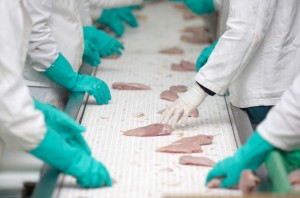 Graduates of food safety training programs will often move on to pursue careers in quality assurance, regulatory affairs, or perhaps even plant sanitation. Professionals working in plant sanitation recognize that cleaning and disinfecting are some of the most important activities that can be performed in a food production plant. Many of us have been exposed to the consequences of an unsanitary food plant – whether it was by personally consuming bacteria-ridden food or hearing about someone else’s unfortunate experience. Failure to produce food items in a hygienic environment can result in the spread of food-borne illnesses as well as food spoilage. This is why it’s important for plant sanitation workers to understand the correct techniques that must be used to clean and disinfect a food production plant.
Graduates of food safety training programs will often move on to pursue careers in quality assurance, regulatory affairs, or perhaps even plant sanitation. Professionals working in plant sanitation recognize that cleaning and disinfecting are some of the most important activities that can be performed in a food production plant. Many of us have been exposed to the consequences of an unsanitary food plant – whether it was by personally consuming bacteria-ridden food or hearing about someone else’s unfortunate experience. Failure to produce food items in a hygienic environment can result in the spread of food-borne illnesses as well as food spoilage. This is why it’s important for plant sanitation workers to understand the correct techniques that must be used to clean and disinfect a food production plant.
A Hidden Cause of Food-borne Illness
Many people assume that food-borne illnesses are a result of bacteria-infested cattle, or perhaps of food simply being undercooked. Anyone with HACCP certification knows that these factors can indeed cause food-borne illnesses – however, there is another source that many seem to overlook. Experts with food quality training understand that production plants must be cleaned regularly to prevent food from being exposed to lingering bacteria. Of course, a thorough cleaning includes more than just wiping down equipment that has direct contact with the food.
More than Just a Clean Sweep
Dirt and organic substances, like fats and protein particles, can accumulate on the surfaces of walls, floors and tools over time. While approximately 90% or more of these substances can be removed through simple cleaning procedures, there are some microorganisms that tend to stick very firmly to surfaces and can be quite difficult to remove – in fact, if they are not properly removed, they may even multiply. Read on to find out which techniques professionals are using to ensure this does not happen.
Dry Cleaning
Any plant sanitation worker knows that the first step to effectively cleaning a food plant includes removing any scraps from the floors and equipment. This step requires no water and is normally done using only a dry brush, broom, and shovel.
Manual Cleaning
This method uses brushes and scrapers, as well as large amounts of water to manually remove and clean any and all surfaces and equipment. Experts know that this technique would only be used in smaller plants because it can be quite time consuming.
High Pressure Cleaning
This method is most commonly used in larger food plants, particularly ones within the meat production industry. The technique effectively cleans surfaces after they’ve been dry-cleaned and scraps have been removed. Using pressurized water, a sanitation worker will be able to remove any remaining particles, blood and dirt from the floors and walls. High pressure cleaning will also remove meat and fat particles, as well as layers of protein from all of the tools and equipment.
Are there other ways you can think of to help avoid an unsanitary production plant?



